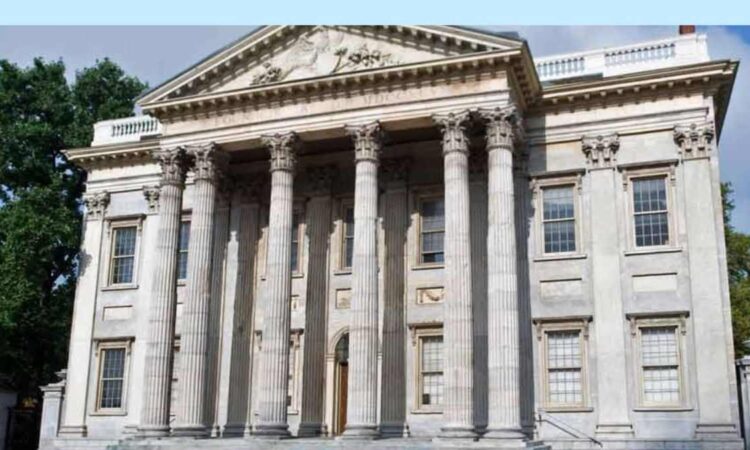
Ever wonder how a single institution could direct a newly developed nation out of financial chaos? Imagine the United States, drowning in debt and confusion after the Revolutionary War. Alexander Hamilton enters, with a bold plan to create the nation’s first central bank.
According to the National Park Service (NPS) in the United States, Congress granted the First Bank of the United States a 20-year charter in December 1791, giving the young country a much-needed financial backbone.
Though it didn’t control fiscal policy, the bank’s influence was intense. Its banknotes became the closest thing to a national currency, and it collected federal taxes. It also helped to clear a large portion of the debt incurred during the Revolutionary War on behalf of the government. However, when the charter expired in 1811, Congress chose not to renew it.
First Bank of the United States: Constitutional Debates
One of the oldest political conflicts in the country began with the establishment of the First Bank of the United States. Secretary of State Thomas Jefferson was one of the main opponents of the concept, claiming that the U.S. Constitution did not specifically allow the establishment of a national bank.
Alexander Hamilton, the Treasury Secretary, on the other hand, held that anything that was not prohibited was allowed. This is how the discussion went:
- Jefferson promoted a strict reading of the Constitution and pushed President Washington to veto the bill.
- Undecided, George Washington granted Hamilton a week to address Jefferson’s concerns.
- In the end, Hamilton’s persuasive 15,000-word response persuaded Washington to back the bank.
Also read | What is the First Republic Bank? All you need to know
The Financial Role and Influence of the First Bank
With a healthy $10 million at launch, it was the biggest corporation in the young country as well as the biggest bank. The government provided $2 million, with private investors providing the remaining $8 million.
The bank was crucial to the federal government’s revenue collection efforts. It was responsible for tax collection, government fund safeguarding, government loan distribution, government deposit distribution through branch network management, and interest payments to European investors on U.S. government assets. A noteworthy event was the bank’s 1791 initial public offering (IPO) when subscriptions sold out quickly and fierce bidding was on the secondary market.
Strict oversight procedures were in place, even though some Americans were uncomfortable with foreign ownership of the bank (despite foreign shareholders having no voting rights). The government, being the major stakeholder, maintained the power to oversee the bank’s activities, solicit periodic financial statements, and take deposits whenever they pleased.
The Bank of the United States was not allowed to buy US government bonds to uphold financial integrity and prevent economic instability. This was a crucial precaution against inflation and perceived conflicts of interest.
The Building of the First Bank in the US
The First Bank of the United States began operations in Carpenters’ Hall on Chestnut Street in 1791. However, it relocated to a brand-new location on South Third Street six years later, a structure that came to represent stability and financial strength.
The bank’s new headquarters, created by architect Samuel Blodgett, Jr., was no typical building. Built of brick, it had a magnificent façade of blue marble that suggested stability and dependability. It stood three stories tall.
The building itself spoke a lot about banking and money. A marble keystone at the main entrance depicted Mercury, the ancient Roman god of trade. The scene above was a carved marble panel depicting a baby (symbolizing America) resting on a globe labeled “Africa,” which represented the continent’s richness.
A cornucopia nearby spilled money instead of fruit, symbolizing wealth. Tall bookcases behind the newborn represented financial records and knowledge, while an American flag and sailing ships indicated affluence and pride in the country’s maritime past.
Claudius LeGrand sculpted a superb eagle onto the building’s triangular pediment, which hung above the columns. The eagle is one of the first architectural depictions of the United States’ Great Seal.
To sum it up, the First Bank of the United States wasn’t just a financial institution—it was a statement of America’s economic prowess and national identity, etched in stone and marble on the bustling streets of early Philadelphia.
You may like | Top 10 Largest Banks in the World 2024





